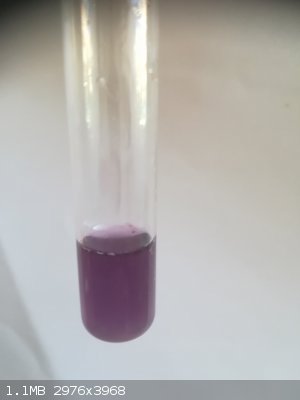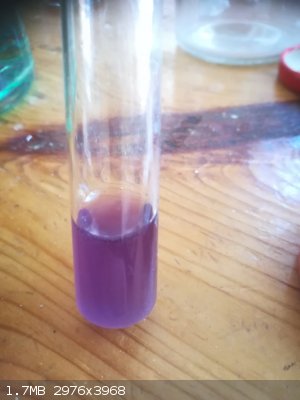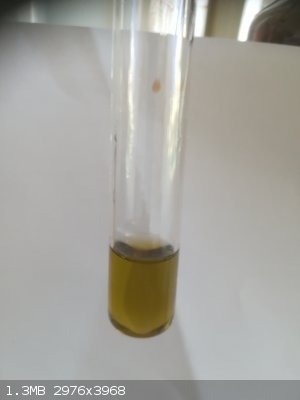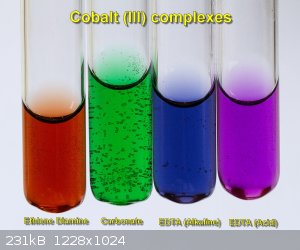Bedlasky
International Hazard
    
Posts: 1219
Registered: 15-4-2019
Location: Period 5, group 6
Member Is Offline
Mood: Volatile
|
|
Preparation of Mn3+ and Co3+
Hi.
I want to try preparation of solution of Mn3+. I plan dissolve small amount of MnCl2 or MnSO4 in few mils of concentrated H2SO4 and add few drops of
aqueous solution of KMnO4.
Is similar reaction possible with CoCl2? For example oxidation with few drops of 10% H2O2 in conc. H2SO4? I found only that Co3+ is prepare by
electrolytic oxidation of Co2+ in conc. H2SO4 or acetic acid.
|
|
|
Boffis
International Hazard
    
Posts: 1836
Registered: 1-5-2011
Member Is Offline
Mood: No Mood
|
|
Mn3+ liberates chlorine from chlorides so you must have a chloride free starting solution. Both simple Mn3+ and Co3+ salts hydrolyse rapidly in water
so you need to work in a medium with low water availability such as glacial acetic acid or concentrated sulphuric acid. If you are preparing the
sulphates high concentrations of sulphate ions also help improve stability. Check out Brauer on the web site library I think it has the preparation of
cobalt alum.
Complex compounds of Mn3+ and Co3+ are much more stable in aqueous solution and there are an insane number of these compounds, particularly those of
cobalt. Again check out Brauer for details and idea.
The simplest Mn3+ compound is probably the trioxalatomanganate III complex
|
|
|
DraconicAcid
International Hazard
    
Posts: 4278
Registered: 1-2-2013
Location: The tiniest college campus ever....
Member Is Offline
Mood: Semi-victorious.
|
|
The simplest cobalt(III) compound to make is the tricarbonato complex.
Please remember: "Filtrate" is not a verb.
Write up your lab reports the way your instructor wants them, not the way your ex-instructor wants them.
|
|
|
AJKOER
Radically Dubious
    
Posts: 3026
Registered: 7-5-2011
Member Is Offline
Mood: No Mood
|
|
Here is a path to convert Co(ll) to Co(lll), to quote from Doctor Brown at http://www.docbrown.info/page07/transition07Co.htm:
"When excess ammonia is added to a cobalt(II) salt solution, the hexamine complex is formed BUT this is unstable in the presence of dissolved oxygen
and is oxidised to the cobalt(III) complex. This change in cobalt's oxidation state from +2 to +3 via an oxidising agent is quite common if a
complexing agent is present too.
[Co(H2O)6]2+(aq) + 6NH3(aq) ==> [Co(NH3)6]2+(aq) + 6H2O(l)
pink hexaaquacobalt(II) ion == oxygen ==> brown hexaamminecobalt(II) ion.
This is an example of an cobalt complex ligand exchange reaction, 6 ammonia molecules displacing 6 water molecules.
........
In most ligand exchange reactions there is no change in oxidation state unless a reducing agent or oxidising agent is present (see below with oxygen
or hydrogen peroxide present).
Transition metal commonly form octahedral complexes, like those of cobalt, with small ligands like water, ammonia and hydroxide ion.
In this case transition metal complex chemistry, oxidation follows either from dissolved oxygen, or you can add hydrogen peroxide for a more efficient
job!
The cobalt(III) complex is stabilised compared to the cobalt(II) complex by the change of ligand from water to ammonia.
(i) 4[Co(NH3)6]2+(aq) + O2(g/aq) + 4H+(aq) ==> 4[Co(NH3)6]3+(aq) + 2H2O(l)
(ii) 2[Co(NH3)6]2+(aq) + H2O2(g/aq) + 2H+(aq) ==> 2[Co(NH3)6]3+(aq) + 2H2O(l) "
---------------------------------------------
As NH4+ = H+ + NH3, I recommend using an ammonium salt, like ammonium chloride, or carbonate as the source of H+ as performed in the improved
commercial leaching of copper ore with ammonium carbonate (mentioned in one of my recent threads).
If you want the detailed half cell reactions, I suspect it also follows the electrochemistry of Cu/NH3/O2, so see my recent thread comments for
reference links.
[Edited on 23-6-2019 by AJKOER]
|
|
|
Bedlasky
International Hazard
    
Posts: 1219
Registered: 15-4-2019
Location: Period 5, group 6
Member Is Offline
Mood: Volatile
|
|
Thanks for answers.
These stable complexes would be nice demonstrations. But I am curious about preparation of hexaaqua complexes. About preparation [Mn(H2O)6]3+ I
something read some time ago. But about [Co(H2O)6]3+ isn't much materials. But thanks for few interesting suggestions.
|
|
|
woelen
Super Administrator
        
Posts: 7976
Registered: 20-8-2005
Location: Netherlands
Member Is Offline
Mood: interested
|
|
Cobalt(II) is not easily oxidized to cobalt(III) with only water as ligand. Hydrogen peroxide does not do the job. Maybe you could have some success
with peroxodisulfate ion, but I'm not sure about that. Keep pH very low if you try this, because at near neutral pH, you will get a black precipitate
of a mixed oxide (probably Co3O4).
Manganese(III) can be made from manganese(II) and KMnO4, but this requires very low pH, such as in 10% H2SO4 or 10% HNO3.
|
|
|
Bedlasky
International Hazard
    
Posts: 1219
Registered: 15-4-2019
Location: Period 5, group 6
Member Is Offline
Mood: Volatile
|
|
Quote: Originally posted by woelen  | Cobalt(II) is not easily oxidized to cobalt(III) with only water as ligand. Hydrogen peroxide does not do the job. Maybe you could have some success
with peroxodisulfate ion, but I'm not sure about that. Keep pH very low if you try this, because at near neutral pH, you will get a black precipitate
of a mixed oxide (probably Co3O4).
Manganese(III) can be made from manganese(II) and KMnO4, but this requires very low pH, such as in 10% H2SO4 or 10% HNO3. |
I plan make it in 96% H2SO4. I'll tomorrow make some MnSO4 and CoSO4 from chlorides, crystalize it and try these two oxidations. [Mn(H2O)6]3+ is red
and Cs and Rb cobalt(III) alums are dark blue according to few texts.
|
|
|
AJKOER
Radically Dubious
    
Posts: 3026
Registered: 7-5-2011
Member Is Offline
Mood: No Mood
|
|
Working with prepared Mn nano-particles does provide a path to Mn3O4 (and beyond), where Manganese is present in two oxidation states +2 and +3 in
the form MnO.Mn2O3.
This article details some of the results working with just O2 and H2O2 on associated nano particles http://nfml.yonsei.ac.kr/gnuboard4/data/file/publication/277... .
|
|
|
Bedlasky
International Hazard
    
Posts: 1219
Registered: 15-4-2019
Location: Period 5, group 6
Member Is Offline
Mood: Volatile
|
|
So I tried prepare these two hexaaqua ions and here are results:
I dissolved small amount of manganese sulfate in two drops of water. After that I added two mils of concentrated sulfuric acid. Little bit of white
precipitate was formed. Then I added drop of potassium permanganate and swirl. Solution turned colour in to violet. I added another drop of
permanganate for more intense coloration. This colour was caused by bridged complex ions [(H2O)4Mn(SO4)2Mn(H2O)4]2+; [(H2O)4Mn(OH)2Mn(H2O)4]4+ and
[(H2O)4Mn(H2O)2Mn(H2O)4]6+ along to [Mn(H2O)6]3+.
I tried similar experiment with cobalt sulfate and hydrogen peroxide, but oxidation didn't take place.
 
[Edited on 1-7-2019 by Bedlasky]
|
|
|
j_sum1
Administrator
       
Posts: 6218
Registered: 4-10-2014
Location: Unmoved
Member Is Offline
Mood: Organised
|
|
This site may be useful.
http://www.explorechem.com/home.html
There are no Co(III) aqua complexes mentioned but there is a different Co(III) complex that is quite interesting.
There is also a preparation of Mn(III) which is rather pretty.
And lots more besides...
|
|
|
woelen
Super Administrator
        
Posts: 7976
Registered: 20-8-2005
Location: Netherlands
Member Is Offline
Mood: interested
|
|
As a side check, I would also try adding a few drops of dilute permanganate solution to conc. sulfuric acid. This should give a green solution. With
the manganese(II) it gives a violet solution. I just want to be sure that the violet solution is not just very dilute permanganate.
Try this experiment if you have the chemicals. It really is interesting:
Needed compounds:
-----------------
potassium chlorate : KClO3
potassium nitrate : KNO3
manganese (II) sulfate : MnSO4 . H2O
phosphoric acid : H3PO4
Summary:
--------
In concentrated phosphoric acid, manganese (II) ions are oxidized easily to
manganese (III) ions, which are stabilized by formation of a phosphato-complex
with a remarkably bright purple color. This reaction is remarkable in the sense
that oxidation stops at manganese (III).
Description:
------------
Add some manganese sulfate to 85% H3PO4 and heat: The solid dissolves and a
colorless liquid is obtained.
Experiment 1
------------
Add some solid KNO3 to the hot solution of manganese sulfate in conc. H3PO4 and
heat, until the liquid slightly boils: The KNO3 dissolves and slowly, the color
of the liquid changes from colorless to beautifully bright purple. If heating
is continued for several minutes, then the liquid becomes quite dark purple.
Experiment 2
------------
Add some solid KClO3 to the hot solution of manganese sulfate in conc. H3PO4:
As soon as the solid touches the hot liquid, it oxidizes the manganese (II) to
a brown solid. Probably this is MnO2. Beware, the reaction of the KClO3 can be
violent. A crackling noise is heard, when the KClO3 reacts. On further heating,
the brown solid dissolves and the liquid becomes bright purple. A faint smell
of Cl2 can be observed.
Remark: The deep purple compound is a complex of manganese (III), it is
[Mn(PO4)2](3-). When a lot of water is added, then the liquid becomes turbid
and brown. This complex only is stable in very concentrated acids. Chlorate
is too strongly oxidizing, nitrate is just good for making the complex.
|
|
|
Bedlasky
International Hazard
    
Posts: 1219
Registered: 15-4-2019
Location: Period 5, group 6
Member Is Offline
Mood: Volatile
|
|
Woelen: I tried add only potassium permanganate to conc. H2SO4 after I this experiment firstly made - I expected green colour too, but it was rather
brown-green (see the picture). Violet colour was caused certainly by Mn(III) complexes. I downloaded text about preparation of Mn(III) in conc. H2SO4
and H3PO4 on this link if you interested: http://downloads.hindawi.com/journals/jchem/2009/736463.pdf

|
|
|
DraconicAcid
International Hazard
    
Posts: 4278
Registered: 1-2-2013
Location: The tiniest college campus ever....
Member Is Offline
Mood: Semi-victorious.
|
|
I tried making potassium tris(malonato)manganate(III) (K3[Mn(mal)3]) once or twice. I'm pretty sure I made it in solution (beautiful cherry-red), but
could not get it to crystallize. I figured that since malonate is far less easy to oxidize than oxalate, it would be more stable than the
tris(oxalate) ion. I did manage to crystallize potassium tris(oxalate)ferrate(III), but its solubility was too similar to that of potassium malonate
to give a pure product.
| Quote: | Remark: The deep purple compound is a complex of manganese (III), it is
[Mn(PO4)2](3-). When a lot of water is added, then the liquid becomes turbid
and brown. This complex only is stable in very concentrated acids. Chlorate
is too strongly oxidizing, nitrate is just good for making the complex. |
If it's only stable in concentrated acids, how can you be sure it isn't something like [Mn(HPO4)2](-) or [Mn(H2PO4)2](+)? Has it been isolated in the
solid state?
[Edited on 2-7-2019 by DraconicAcid]
Please remember: "Filtrate" is not a verb.
Write up your lab reports the way your instructor wants them, not the way your ex-instructor wants them.
|
|
|
woelen
Super Administrator
        
Posts: 7976
Registered: 20-8-2005
Location: Netherlands
Member Is Offline
Mood: interested
|
|
@DraconicAcid: You're right, the complex could be something based on HPO4(2-) or H2PO4(-). I did not isolate any solid. I simply did not think of the
acidic ions of phosphate.
@Bedlasky: Nice that you do all these interesting experiments. These experiments also urged me to do some experimenting again, despite my very small
amount of free time for this 
I first dissolved some MnSO4.H2O in concentrated H2SO4. Quite some heating is necessary to get it dissolved. The solution is colorless. I let the
solution cool down to allow safe addition of water to this solution.
I took a single drop of a solution of KMnO4 and added this to the cold solution of MnSO4.H2O in H2SO4. This indeed gives a violet solution. The color
is not really bright, it is a somewhat dull color. The left picture with the off-white background quite well shows the color of the solution.
Next, I took a small amount of the colorless solution of MnSO4.H2O in H2SO4 and added a little solid KNO3. I started heating gently. The KNO3 fairly
quickly dissolves in the acid and at a certain point in time, the liquid turns violet. The color is very similar to what I get with addition of KMnO4.
Now, I can get a more intensely colored solution, because in this experiment I could add a little more KNO3 without adding too much water. On stronger
heating, the violet color goes away again. It becomes brown and it also fades, I see bubbles of gas, the nitrate/HNO3 boils off, but also decomposes.
Brown gas is formed above the liquid. On shaking, the brown gas reduces part of the manganese(III), the color fades.
When this experiment is compared to the one I did with H3PO4, then there is some similarity in the observed reactions, but with H3PO4, the color of
the produced solutions is much more brilliant. With H3PO4 you get a really beautiful, highly saturated purple color.
I repeated the same experiment with Mn(CH3COO)2. With this, I did not get good results. The acetate ion, which is quite stable and not strongly
reducing in aqueous solutions, it fairly easily oxidized in the strong H2SO4. With KNO3 added, on heating there is quite a lot of production of gas. I
obtained a violet solution, but almost instantly, when the color appeared, it also faded again and there was a vigorous production of colorless gas,
mixed with a small amount of brown gas.
These experiments convinced me that indeed compounds of manganese(III) are formed in the strong H2SO4. The color of the Mn(3+) is different from the
color in H3PO4. This almost certainly is due to the different coordinating environments.
|
|
|
Bedlasky
International Hazard
    
Posts: 1219
Registered: 15-4-2019
Location: Period 5, group 6
Member Is Offline
Mood: Volatile
|
|
Woelen: If you have fumehood and glacial acetic acid you may try preparation of manganese(III) acetate from manganese(II) acetate. I don't have
equipment for this.
https://erowid.org/archive/rhodium/chemistry/manganous.acetate.html
In phosphoric acid is maybe forme pyrophosphate complex, but I don't sure about that (see page 811)
[Edited on 3-7-2019 by Bedlasky]
|
|
|
nezza
Hazard to Others
  
Posts: 324
Registered: 17-4-2011
Location: UK
Member Is Offline
Mood: phosphorescent
|
|
In acid solution Co(III) and Mn(III) are difficult to prepare. In alkaline solution Co(III) and Mn(III) are more stable than the divalent ions. In
particular in the presence of complexing agents (EDTA or Ethylene diamine) Co(II) can be easily oxidised to Co(III) with Hydrogen peroxide. The
complex with Carbonate is particularly interesting as it is bright Green.

If you're not part of the solution, you're part of the precipitate.
|
|
|
Bedlasky
International Hazard
    
Posts: 1219
Registered: 15-4-2019
Location: Period 5, group 6
Member Is Offline
Mood: Volatile
|
|
Nezza: Carbonate complex have nice colour  . .
Woelen: I've got an idea why is MnO3+ ion brown-green instead green if you make it from permanganate solution and conc. sulfuric acid. Maybe this ion
partially decomposes in to MnO2 and O2/O3. Maybe it would be more stable in super acidic media (for example in oleum or H2SO4/H3BO3 system - these are
most common superacids).
[Edited on 8-7-2019 by Bedlasky]
|
|
|
fusso
International Hazard
    
Posts: 1922
Registered: 23-6-2017
Location: 4 ∥ universes ahead of you
Member Is Offline
|
|
Quote: Originally posted by Bedlasky  | Nezza: Carbonate complex have nice colour  . .
Woelen: I've got an idea why is MnO3+ ion brown-green instead green if you make it from permanganate solution and conc. sulfuric acid. Maybe this ion
partially decomposes in to MnO2 and O2/O3. Maybe it would be more stable in super acidic media (for example in oleum or H2SO4/H3BO3 system - these are
most common superacids).
[Edited on 8-7-2019 by Bedlasky] |
Why is H2SO4/H3BO3 system superacid?
|
|
|
AJKOER
Radically Dubious
    
Posts: 3026
Registered: 7-5-2011
Member Is Offline
Mood: No Mood
|
|
To quote a source (https://www.revolvy.com/page/Superacid ) :
"Most strong superacids are prepared by the combination of a strong Lewis acid and a strong Brønsted acid."
with the key word 'most'. Per another source (https://forums.studentdoctor.net/threads/sulfuric-acid-as-a-... ):
"H2So4 is a lewis acid because it is a bronsted acid. ALL bronsted acids are lewis acids (but not the other way around). H2SO4 is not amphoteric
because it can not act as a base."
In the case of Boric acid, Wikipedia does also note that it is a Lewis acid (actually a weak monobasic Lewis acid) and a special form of a Bronsted
acid (a tribasic Brønsted acid).
So, I would guess that one could think of the H2SO4/H3BO3 superacid system as a less common variant of superacid systems.
[Edited on 9-7-2019 by AJKOER]
|
|
|
Bedlasky
International Hazard
    
Posts: 1219
Registered: 15-4-2019
Location: Period 5, group 6
Member Is Offline
Mood: Volatile
|
|
Because boric acid forms with bisulfate complex:
1. 2H2SO4 <--> H3SO4+ + HSO4-
2. H3BO3 + 6H2SO4 <--> [B(HSO4)4]- + 2HSO4- + 6H3O+
Boric acid binds bisulfates, so the first equilibrum is shift more to right side --> higher content of H3SO4+ --> higher acidity.
Better is use boric acid in dilute oleum because of H3O+ ions.
H3BO3 + 3H2S2O7 <--> [B(HSO4)4]- + H3SO4+ + H2SO4
Look on this document on page 95. There is table of Hammett acidity function of H3BO3/H2SO4 system depending on the concentration of boron-bisulfate complex.
[Edited on 9-7-2019 by Bedlasky]
|
|
|
woelen
Super Administrator
        
Posts: 7976
Registered: 20-8-2005
Location: Netherlands
Member Is Offline
Mood: interested
|
|
Another easier method of having less water would be to use H2SO4 and B2O3. Oleum is extremely hard to get your hands on and it is not easy to handle
that safely in a home setting. B2O3 on the other hand is quite benign and can be made from H3BO3. I have a few hundreds of grams of B2O3 lying around.
It actually is quite boring stuff.
This is something I may try next weekend, mixing H2SO4 and B2O3 and then adding a tiny amount of KMnO4 and see what happens.
|
|
|